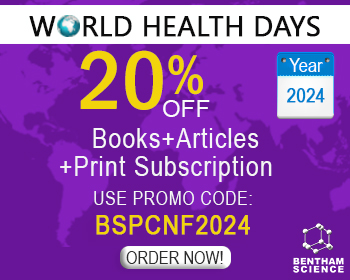Abstract
Cancer is a pathology that impacts in a profound manner all over the world. The election strategy against cancer often uses chemotherapy and radiotherapy, which, more often than not, can present many side effects and are not always considered reliable efficacy. By contrast, it is widely known that a diet rich in fruit and vegetables has a protective effect against cancer insurgence and development. Polyphenols are generally believed to be responsible for those beneficial actions, at least partially. In this review, we highlight the metabolic interaction between polyphenols and our metabolism and discuss their potential for anticancer prevention and therapy.
Keywords: Cancer, biological chemistry, chemoprevention, dietary antioxidants, clinical biochemistry and clinical molecular biology, polyphenols, clinical microbiology, translational medicine.
[http://dx.doi.org/10.3322/caac.21660] [PMID: 33538338]
[http://dx.doi.org/10.1093/fqsafe/fyz021]
[http://dx.doi.org/10.3390/nu8030156] [PMID: 26978396]
[http://dx.doi.org/10.3390/antiox9121263] [PMID: 33322700]
[http://dx.doi.org/10.3389/fpls.2019.00835] [PMID: 31316537]
[http://dx.doi.org/10.3892/ijo.2018.4661] [PMID: 30570109]
[http://dx.doi.org/10.1016/j.jnutbio.2016.11.007] [PMID: 27951449]
[http://dx.doi.org/10.1016/j.phytochem.2020.112588] [PMID: 33232863]
[http://dx.doi.org/10.3389/fnut.2018.00087] [PMID: 30298133]
[http://dx.doi.org/10.1080/10942912.2016.1220393]
[http://dx.doi.org/10.5740/jaoacint.19-0133] [PMID: 31200785]
[http://dx.doi.org/10.1093/ajcn/79.5.727] [PMID: 15113710]
[http://dx.doi.org/10.3390/nu6126020] [PMID: 25533011]
[http://dx.doi.org/10.1002/biof.1363] [PMID: 28497905]
[http://dx.doi.org/10.1021/jf000025h] [PMID: 10820089]
[http://dx.doi.org/10.1021/jf000026+] [PMID: 10820090]
[http://dx.doi.org/10.1089/152308601317203549] [PMID: 11813977]
[http://dx.doi.org/10.2174/09298673113209990158] [PMID: 23834175]
[http://dx.doi.org/10.3390/molecules24020370] [PMID: 30669635]
[http://dx.doi.org/10.2174/157488406775268246] [PMID: 18666380]
[http://dx.doi.org/10.1080/10408398.2016.1263597] [PMID: 28001084]
[http://dx.doi.org/10.3109/07853899709113696] [PMID: 9187225]
[http://dx.doi.org/10.3390/molecules24050917] [PMID: 30845651]
[http://dx.doi.org/10.3390/ijms12118181] [PMID: 22174658]
[http://dx.doi.org/10.3390/nu7125530] [PMID: 26690212]
[http://dx.doi.org/10.3390/ijms20051062] [PMID: 30823649]
[http://dx.doi.org/10.1079/BJN20061714] [PMID: 16869989]
[http://dx.doi.org/10.1016/s0753-3322(02)00205-6]
[http://dx.doi.org/10.1517/17425255.3.3.389] [PMID: 17539746]
[PMID: 18209268]
[http://dx.doi.org/10.1002/ptr.6419] [PMID: 31359516]
[http://dx.doi.org/10.1155/2015/905215] [PMID: 25802870]
[http://dx.doi.org/10.3748/wjg.v26.i6.562] [PMID: 32103869]
[http://dx.doi.org/10.1080/01635581.2013.767367] [PMID: 23530632]
[http://dx.doi.org/10.3389/fimmu.2019.00729] [PMID: 31031748]
[http://dx.doi.org/10.1371/journal.pone.0247492] [PMID: 33690618]
[http://dx.doi.org/10.1016/j.phrs.2019.104584] [PMID: 31809853]
[http://dx.doi.org/10.3390/nu8090552] [PMID: 27618095]
[http://dx.doi.org/10.2174/138945012804545560] [PMID: 23140285]
[http://dx.doi.org/10.2741/4180] [PMID: 23747884]
[http://dx.doi.org/10.3390/ijms19030686] [PMID: 29495598]
[http://dx.doi.org/10.2174/1871520619666190416101622] [PMID: 31038081]
[http://dx.doi.org/10.1016/j.jnutbio.2009.03.012] [PMID: 19576748]
[http://dx.doi.org/10.1002/biof.1366] [PMID: 28612982]
[http://dx.doi.org/10.18632/oncotarget.16854] [PMID: 28430586]
[http://dx.doi.org/10.18632/oncotarget.20544] [PMID: 29137335]
[http://dx.doi.org/10.1136/pmj.78.924.584] [PMID: 12415079]
[http://dx.doi.org/10.1128/MCB.25.17.7734-7742.2005] [PMID: 16107719]
[http://dx.doi.org/10.1111/febs.14809] [PMID: 30892828]
[http://dx.doi.org/10.1158/0008-5472.CAN-08-2331] [PMID: 19190345]
[http://dx.doi.org/10.1038/onc.2009.410] [PMID: 19946332]
[http://dx.doi.org/10.2174/1871530319666190823160230] [PMID: 31441735]
[http://dx.doi.org/10.3892/mmr.2012.1103] [PMID: 23023821]
[http://dx.doi.org/10.4161/cbt.8.14.8720] [PMID: 19448398]
[http://dx.doi.org/10.1007/s13346-017-0377-4] [PMID: 28417445]
[PMID: 23489691]
[PMID: 17201164]
[http://dx.doi.org/10.1101/cshperspect.a000034] [PMID: 20066092]
[http://dx.doi.org/10.1016/j.gde.2008.01.020] [PMID: 18440219]
[http://dx.doi.org/10.3181/0707-MR-196] [PMID: 18156302]
[http://dx.doi.org/10.1038/sj.onc.1207353] [PMID: 14676829]
[http://dx.doi.org/10.1158/0008-5472.CAN-08-2232] [PMID: 18922932]
[http://dx.doi.org/10.1158/1940-6207.CAPR-08-0155] [PMID: 19139022]
[http://dx.doi.org/10.1096/fj.04-2126com] [PMID: 15522912]
[http://dx.doi.org/10.1002/mc.20170] [PMID: 16526022]
[http://dx.doi.org/10.1177/1010428317692266] [PMID: 28621241]
[http://dx.doi.org/10.2174/1566524018666171219101937.Mimeault] [PMID: 29256350]
[http://dx.doi.org/10.1158/1535-7163.MCT-09-1013]
[http://dx.doi.org/10.1158/0008-5472.CAN-09-3012] [PMID: 20395211]
[http://dx.doi.org/10.3892/or.2015.4504] [PMID: 26707376]
[http://dx.doi.org/10.1016/j.taap.2016.03.016] [PMID: 27058323]
[http://dx.doi.org/10.1146/annurev.pharmtox.41.1.367] [PMID: 11264462]
[http://dx.doi.org/10.1038/471310a] [PMID: 21412328]
[http://dx.doi.org/10.1080/1061186X.2018.1523415] [PMID: 30207743]
[http://dx.doi.org/10.1002/mnfr.201200503] [PMID: 23193056]
[http://dx.doi.org/10.1016/j.chroma.2016.12.020] [PMID: 28024731]
[http://dx.doi.org/10.1002/mc.20571] [PMID: 19676105]
[http://dx.doi.org/10.1093/jn/135.3.609] [PMID: 15735102]
[http://dx.doi.org/10.1111/j.1753-4887.2008.00076.x] [PMID: 18667005]
[http://dx.doi.org/10.1158/1940-6207.CAPR-08-0160] [PMID: 19401532]
[http://dx.doi.org/10.3892/ijo.2017.3859] [PMID: 28197625]
[http://dx.doi.org/10.1158/1940-6207.CAPR-09-0155] [PMID: 20716633]
[http://dx.doi.org/10.3389/fphys.2011.00030] [PMID: 21747767]
[http://dx.doi.org/10.1016/S0092-8674(03)00934-6] [PMID: 14675539]
[http://dx.doi.org/10.1172/JCI27987] [PMID: 16511588]
[http://dx.doi.org/10.1146/annurev-physiol-030212-183708] [PMID: 23043248]
[http://dx.doi.org/10.1210/er.2003-0010] [PMID: 15583021]
[http://dx.doi.org/10.1038/nrc3093] [PMID: 21779010]
[PMID: 9731492]
[http://dx.doi.org/10.1007/s10549-006-9191-2] [PMID: 16541309]
[http://dx.doi.org/10.1016/j.jnutbio.2009.09.012] [PMID: 20153625]
[http://dx.doi.org/10.3390/ijms19092624] [PMID: 30189583]
[http://dx.doi.org/10.1055/s-0032-1328300] [PMID: 23479392]
[http://dx.doi.org/10.1101/cshperspect.a026245] [PMID: 28270530]
[http://dx.doi.org/10.3390/cancers10050135]
[http://dx.doi.org/10.1371/journal.pone.0149014] [PMID: 26863418]
[http://dx.doi.org/10.1016/j.tiv.2018.04.014]
[http://dx.doi.org/10.1016/j.ejphar.2018.09.005] [PMID: 30194939]
[http://dx.doi.org/10.3945/an.114.007500] [PMID: 25593144]
[http://dx.doi.org/10.3892/ol.2017.5657] [PMID: 28454339]
[http://dx.doi.org/10.3892/ijo.2012.1449] [PMID: 22552582]
[http://dx.doi.org/10.1186/s12929-018-0422-8] [PMID: 29526163]
[http://dx.doi.org/10.1016/j.psyneuen.2018.10.019] [PMID: 30445409]
[http://dx.doi.org/10.1590/1414-431x20176891] [PMID: 29513793]
[http://dx.doi.org/10.1016/j.bbcan.2010.10.003] [PMID: 20951769]
[http://dx.doi.org/10.1016/j.jams.2013.07.002] [PMID: 24139463]
[http://dx.doi.org/10.1186/s12935-015-0186-0] [PMID: 25859163]
[PMID: 9066634]
[http://dx.doi.org/10.18632/genesandcancer.52] [PMID: 25821561]
[http://dx.doi.org/10.2174/187152012803833035] [PMID: 22583402]
[http://dx.doi.org/10.1016/j.bcp.2017.11.021] [PMID: 29203368]
[http://dx.doi.org/10.1096/fj.10-178871] [PMID: 21737614]
[http://dx.doi.org/10.1038/nrc1736] [PMID: 16239906]
[http://dx.doi.org/10.1155/2018/1290179] [PMID: 29854724]
[http://dx.doi.org/10.3389/fimmu.2013.00132] [PMID: 23761791]
[http://dx.doi.org/10.1016/j.jprot.2018.02.009] [PMID: 29432917]
[http://dx.doi.org/10.3390/nu9070677] [PMID: 28661454]
[http://dx.doi.org/10.1158/1940-6207.CAPR-09-0117] [PMID: 20332304]
[http://dx.doi.org/10.1006/jsre.2000.5826] [PMID: 10729246]
[http://dx.doi.org/10.1146/annurev.micro.112408.134016] [PMID: 20690823]
[http://dx.doi.org/10.1002/em.22087] [PMID: 28485537]
[http://dx.doi.org/10.1038/nbt.1685] [PMID: 20944598]
[http://dx.doi.org/10.1101/cshperspect.a019521] [PMID: 27037415]
[http://dx.doi.org/10.1007/978-3-319-43624-1_4] [PMID: 27826835]
[http://dx.doi.org/10.3390/ijms21051673] [PMID: 32121394]
[http://dx.doi.org/10.1016/j.semcancer.2016.04.002] [PMID: 27117759]
[http://dx.doi.org/10.1016/j.bcp.2010.06.036] [PMID: 20599773]
[http://dx.doi.org/10.1007/978-1-4939-8751-1_7] [PMID: 30178249]
[http://dx.doi.org/10.1016/j.phrs.2012.03.007] [PMID: 22465217]
[http://dx.doi.org/10.1080/10408398.2015.1062353] [PMID: 26357880]
[http://dx.doi.org/10.1017/S0007114511003631] [PMID: 21801466]
[http://dx.doi.org/10.1371/journal.pone.0157866] [PMID: 27355345]
[http://dx.doi.org/10.1371/journal.pone.0155057] [PMID: 27159275]
[http://dx.doi.org/10.1016/j.bcp.2006.11.003] [PMID: 17147953]
[http://dx.doi.org/10.1016/S0092-8674(04)00045-5] [PMID: 14744438]
[http://dx.doi.org/10.1038/nrc1840] [PMID: 16557279]
[http://dx.doi.org/10.1016/j.gde.2005.08.005] [PMID: 16099643]
[http://dx.doi.org/10.1111/j.1582-4934.2008.00510.x] [PMID: 19175697]
[http://dx.doi.org/10.1158/1535-7163.MCT-07-2272] [PMID: 18347134]
[http://dx.doi.org/10.1007/s40495-015-0018-x] [PMID: 26457241]
[http://dx.doi.org/10.1002/ijc.24454] [PMID: 19449378]
[http://dx.doi.org/10.1016/j.ctim.2019.04.011] [PMID: 31331573]
[http://dx.doi.org/10.1111/ecc.13364] [PMID: 33174661]
[http://dx.doi.org/10.1007/s10552-019-01158-2] [PMID: 30903485]
[http://dx.doi.org/10.1007/s10654-018-0408-6] [PMID: 29761424]
[http://dx.doi.org/10.1038/pcan.2017.18] [PMID: 28417981]
[http://dx.doi.org/10.1002/mnfr.201600930] [PMID: 27943649]
[http://dx.doi.org/10.3390/nu10070950] [PMID: 30041489]
[http://dx.doi.org/10.1002/ijc.32589] [PMID: 31342519]
[http://dx.doi.org/10.1017/S0007114518003811] [PMID: 30588893]
[http://dx.doi.org/10.4161/oxim.2.5.9498] [PMID: 20716914]
[http://dx.doi.org/10.3390/medicines4020018] [PMID: 28930233]
[http://dx.doi.org/10.3390/ijms22052354] [PMID: 33652978]
[http://dx.doi.org/10.3109/10408363.2011.631268] [PMID: 22141580]
[http://dx.doi.org/10.3390/ijms17060843] [PMID: 27258251]
[http://dx.doi.org/10.1371/journal.pone.0037736] [PMID: 22768036]
[http://dx.doi.org/10.3748/wjg.v20.i31.10802] [PMID: 25152583]
[http://dx.doi.org/10.1016/j.semcancer.2017.06.010] [PMID: 28673607]
[http://dx.doi.org/10.1016/j.ijpharm.2016.12.030] [PMID: 27988378]
[http://dx.doi.org/10.1093/ajcn/81.1.243S] [PMID: 15640487]


























